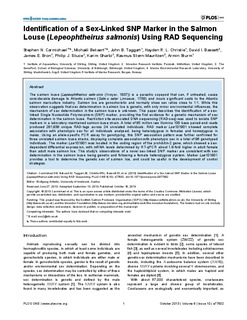| dc.contributor.author | Carmichael, Stephen N. | |
| dc.contributor.author | Bakaert, Michaël | |
| dc.contributor.author | Taggart, John B. | |
| dc.contributor.author | Christie, Hayden R. L. | |
| dc.contributor.author | Bassett, David I. | |
| dc.contributor.author | Bron, James E. | |
| dc.contributor.author | Skuce, Philip J. | |
| dc.contributor.author | Gharb, Karim | |
| dc.contributor.author | Skern-Mauritzen, Rasmus | |
| dc.contributor.author | Sturm, Armin | |
| dc.date.accessioned | 2014-01-24T13:22:31Z | |
| dc.date.available | 2014-01-24T13:22:31Z | |
| dc.date.issued | 2013-10-16 | |
| dc.identifier.citation | Carmichael SN, Bekaert M, Taggart JB, Christie HRL, Bassett DI, et al. (2013) Identification of a Sex-Linked SNP Marker in the Salmon Louse (Lepeophtheirus salmonis) Using RAD Sequencing. PLoS ONE 8(10): e77832. doi:10.1371/journal.pone.0077832 | no_NO |
| dc.identifier.issn | 1932-6203 | |
| dc.identifier.uri | http://hdl.handle.net/11250/109315 | |
| dc.description.abstract | The salmon louse (Lepeophtheirus salmonis (Krøyer, 1837)) is a parasitic copepod that can, if untreated, cause considerable damage to Atlantic salmon (Salmo salar Linnaeus, 1758) and incurs significant costs to the Atlantic salmon mariculture industry. Salmon lice are gonochoristic and normally show sex ratios close to 1:1. While this observation suggests that sex determination in salmon lice is genetic, with only minor environmental influences, the mechanism of sex determination in the salmon louse is unknown. This paper describes the identification of a sex-linked Single Nucleotide Polymorphism (SNP) marker, providing the first evidence for a genetic mechanism of sex determination in the salmon louse. Restriction site-associated DNA sequencing (RAD-seq) was used to isolate SNP markers in a laboratory-maintained salmon louse strain. A total of 85 million raw Illumina 100 base paired-end reads produced 281,838 unique RAD-tags across 24 unrelated individuals. RAD marker Lsa101901 showed complete association with phenotypic sex for all individuals analysed, being heterozygous in females and homozygous in males. Using an allele-specific PCR assay for genotyping, this SNP association pattern was further confirmed for three unrelated salmon louse strains, displaying complete association with phenotypic sex in a total of 96 genotyped individuals. The marker Lsa101901 was located in the coding region of the prohibitin-2 gene, which showed a sex-dependent differential expression, with mRNA levels determined by RT-qPCR about 1.8-fold higher in adult female than adult male salmon lice. This study’s observations of a novel sex-linked SNP marker are consistent with sex determination in the salmon louse being genetic and following a female heterozygous system. Marker Lsa101901 provides a tool to determine the genetic sex of salmon lice, and could be useful in the development of control strategies. | no_NO |
| dc.language.iso | eng | no_NO |
| dc.publisher | Public Library of Science | no_NO |
| dc.title | Identification of a Sex-Linked SNP Marker in the Salmon Louse (Lepeophtheirus salmonis) Using RAD Sequencing | no_NO |
| dc.type | Journal article | no_NO |
| dc.type | Peer reviewed | no_NO |
| dc.subject.nsi | VDP::Agriculture and fishery disciplines: 900::Fisheries science: 920::Fish health: 923 | no_NO |
| dc.source.pagenumber | 8 p. | no_NO |
| dc.source.volume | 8 | no_NO |
| dc.source.journal | PLoS ONE | no_NO |
| dc.source.issue | 10 | no_NO |
| dc.identifier.doi | 10.1371/journal.pone.0077832 | |
